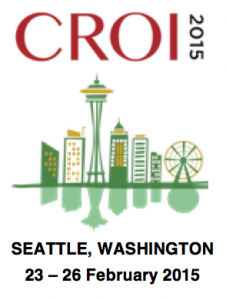Lopinavir/ritonavir superior to nevirapine in children <3 years old: IMPAACT P1060 five year results
24 March 2015. Related: Conference reports, Paediatric care, CROI 22 (Retrovirus) 2015.
Polly Clayden, HIV i-Base

Long-term virologic suppression was superior in children receiving lopinavir/ritonavir (LPV/r)-based ART compared with nevirapine (NVP)-based regimens at five-year follow up in the IMPAACT 1060 trial. Early modest gains in CD4 percentage and growth with NVP were no longer statistically significant beyond one year after starting ART.
Linda Barlow-Mosha presented these findings at CROI 2015 on behalf of the IMPAACT P1060 trial Investigators.
The trial was conducted in six African countries and India. It showed short-term superiority of LPV/r-based ART compared with NVP in HIV positive infants and children for the primary endpoint: stopping randomised treatment, virologic failure or death at 24 weeks. The results were regardless of NVP exposure at birth. Participants receiving NVP had slightly superior improvements in CD4 percentage and weight and height z-scores.
Results from long-term follow up of IMPAACT P1060 in a five-year, observational cohort, were shown.
Infants and children aged 2 months to 3 years were enrolled into two cohorts (exposed or unexposed to NVP through PMTCT) and randomly assigned to start NVP or LPV/r in regimens with AZT and 3TC.
Due to superiority of the LPV/r arm for the primary endpoint, the DSMB recommended stopping enrolment and unblinding the cohort with NVP-exposed participants in 2009 followed by the unexposed cohort in 2010. All participants were eligible to switch regimens and continue in observational follow up. Randomised and observational data were combined in the analyses presented.
There were 229 participants randomised to NVP and 222 to LPV/r based ART. At baseline, median age was 1.2 years and 55% were older than one year. By January 2014, 75% were still in follow up for a median 4.6 years IQR: 3.7-5.7] and 92% had viral load <400 copies/mL.
From the original randomisation, 84% of participants receiving LPV/r remained on treatment compared with 52% receiving NVP. Median time on randomised treatment was: 54 vs 19 months in the LPV/r and NVP arms respectively.
There was 14% higher virologic failure in the NVP arm. For the combined endpoint of time to virologic failure and death the adjusted hazard ratio was 1.9 (95% CI: 1.4 to 2.7).
The initial gains in CD4 percent with NVP vs LPV/r (12-month difference ITT adjusted 1.52 [95% CI: 0.13 to 2.92], p=0.03) were not statistically significant by the second year. The participants in the NVP arm continued to have higher weight for age z-scores throughout the study (36-month difference ITT adjusted 0.22 [95% CI: 0.05 to 0.38], p=0.01). Height for age z-score was only higher in the NVP arm early on (6-month difference ITT adjusted 0.2 [95% CI: 0.01 to 3.9], p=0.04).
Comment
These results support the WHO recommendations of LPV/r-based regimens for first line ART in infants and young children less than 3 years of age.
In reality the problems with the LPV/r liquid formulation remain (it is unpalatable, requires cold chain, and is expensive) and coverage is poor outside South Africa.
Cipla has submitted a solid “pellet” formulation of LPV/r to the FDA (and Mylan is also developing one) – but the taste masking is still not ideal. Cipla in partnership with the Drugs for Neglected Diseases initiative (DNDi), and Mylan are developing 4-in-1 fixed dose combinations of LPV/r granules (finer than pellets with better taste masking), with abacavir or AZT plus 3TC.
Until these formulations are available, the practical challenges associated with giving LPV/r to infants and young children in low-income countries are still with us.
Reference:
Barlow-Mosha L et al. Long-term outcomes of HIV-infected children initiating NVP vs LPV/r-based treatment. CROI 2015. Seattle, Washington. 23-26 February, 2015. Oral abstract 36.
Abstract:
http://www.croiconference.org/sessions/long-term-outcomes-hiv-infected-children-initiating-nvp-vs-lpvr-based-treatment
Webcast:
http://www.croiwebcasts.org/console/player/25556

